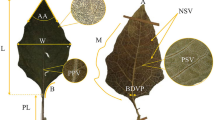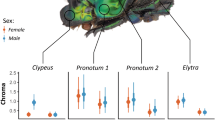Abstract
Sex ratio and sexual dimorphism of Borderea pyrenaica, a long-lived dioecious geophyte endemic to the Pyrenees (north-east Iberian Peninsula), were examined in three alpine populations. In this species, age can be estimated and the sex of nonreproductive adult plants identified. Male plants attain sexual maturity earlier, flower more frequently and grow faster than female plants, whereas females allocate a higher biomass to reproduction than males. These results support the hypothesis that female plants incur a higher cost of sexual reproduction and that this higher cost is measurable as reduced vegetative growth and lower flowering frequency. Variation of sex ratio among young, intermediate and old adults within populations suggests, however, that this higher female reproductive investment does not result in sexual differences in mortality. The overall male-biased sex ratio in B. pyrenaica is mainly a consequence of the tendency of males to reproduce at an earlier age and more frequently than females.
Similar content being viewed by others
References
Ågren J (1988a) Between-year variation in flowering and fruit set in frost-prone and frost-sheltered populations of dioecious Rubus chamaemorus. Oecologia 76: 161–169
Ågren J (1988b) Sexual differences in biomass and nutrient allocation in the dioecious Rubus chamaemorus. Ecology 69: 962–973
Allen GA, Antos JA (1988) Relative reproductive effort in males and females of the dioecious shrub Oemleria cerasiformis. Oecologia 76: 111–118
Allen GA, Antos JA (1993) Sex ratio variation in the dioecious shrub Oemleria cerasiformis. Am Nat 141: 537–553
Alliende MC, Harper JL (1989) Demographic studies of a dioecious tree. I. Colonization, sex and age structure of a population of Salix cinerea. J Ecol 77: 1029–1047
Armstrong JE, Irvine AK (1989) Flowering, sex ratios, pollen-ovule ratios, fruit set, and reproductive effort of a dioecious tree, Myristica insipida (Myristicaceae), in two different tain forest communities. Am J Bot 76: 74–85
Ataroff M, Schwarzkopf T (1992) Leaf production, reproductive patterns, field germination and seedling survival in Chamaedorea bartlingiana, a dioecious understory palm. Oecologia 92: 250–256
Bawa KS (1983) Patterns of flowering in tropical plants In: Jones CE, Little RJ (eds) Handbook of experimental pollination biology. Van Nostrand Reinhold, New York, pp 394–410
Bazzaz FA, Reekie EG (1985) The meaning and measurement of reproductive effort in plants. In: White J (ed) Studies on plant demography: a festschrift for John L. Harper. Academic Press, London, pp 373–287
Bazzaz FA, Carlson RW, Harper JL (1979) Contribution to reproductive effort by photosynthesis of flowers and fruits. Nature 279: 554–555
Bierzychudek P, Eckhart V (1988) Spatial segregation of the sexes of dioecious plants. Am Nat 132: 34–43
Bullock SH (1982) Population structure and reproduction in the neotropical dioecious tree Compsoneura sprucei. Oecologia 55: 238–242
Bullock SH (1992) Effects of size and substrate on growth and mortality of trees in tropical wet forest. Oecologia 91: 52–55
Bullock SH, Bawa KS (1981) Sexual dimorphism and the annual flowering pattern in Jacaratia dolichaula (D. Smith) Woodson (Caricaceae) in a Costa Rican rain forest. Ecology 62: 1494–1504
Bullock SH, Beach JH, Bawa KS (1983) Episodic flowering and sexual dimorphism in Guarea rhopalocarpa in a Costa Rican rain forest. Ecology 64: 851–861
Carroll SB, Mulcahy DL (1993) Progeny sex ratios in dioecious Silene latifolia (Caryophyllaceae). Am J Bot 80: 551–556
Charnov EL (1975) Sex ratio selection in an age-structured population. Evolution 29: 366–368
Cipollini ML, Stiles EW (1991) Costs of reproduction in Nyssa sylvatica: sexual dimorphism in reproductive frequency and nutrient flux. Oecologia 86: 585–593
Cipollini ML, Whigham DF (1994) Sexual dimorphism and cost of reproduction in the dioecious shrub Lindera benzoin (Lauraceae). Am J Bot 81: 65–75
Clark DA, Clark DB (1987) Temporal and environmental patterns of reproduction in Zamia skinneri, a tropical rain forest cycad. J Ecol 75: 135–149
Delph LF, Lu Y, Jayne LD (1993) Patterns of resource allocation in a dioecious carex (Cyperaceae). Am J Bot 80: 607–615
Elmqvist T, Cates RG, Harper JK, Gardfjell H (1991) Flowering in males and females of a Utah willow, Salix rigida and effects on growth, tannins, phenolic glycosides and sugars. Oikos 61: 65–72
Escarré J, Houssard C (1991) Changes in sex ratio in experimental populations of Rumex acetosella. J Ecol 79: 379–387
Fisher RA (1930) The genetical theory of natural selection. Oxford University Press, Oxford
Galen C, Dawson TE, Stanton ML (1993) Carpels as leaves: meeting the carbon cost of reproduction in an alpine buttercup. Oecologia 95: 187–193
García MB (1993) Biologia reproductiva y ecología de plantas endémicas relictas de Los Pirineos. Ph. D. Thesis, University of Navarra, Pamplona
Gehring JL, YB Linhart (1993) Sexual dimorphism and response to low resources in the dioecious plant Silene latifolia (Caryophyllaceae). Int J Plant Sci 154: 152–162
Godley EJ (1976) Sex ratio in Clematis gentianoides DC. New Z J Bot 14: 299–306
Goldman DA, Willson MF (1986) Sex allocation in functionally hermaphroditic plants: a review and critique. Bot Rev 52: 157–194
Grant MC, Mitton JB (1979) Elevational gradients in adult sex ratios and sexual differentiation in vegetative growth rates of Populus tremuloides Michx. Evolution 33: 914–918
Gross KL, Soule JD (1981) Differences in biomass allocation to reproductive and vegetative structures of male and female plants of a dioecious perennial herb, Silene alba (Miller) Krause. Am J Bot 68: 801–807
Hoffmann AJ, Alliende MC (1984) Interactions in the patterns of vegetative growth and reproduction in weedy dioecious plants. Oecologia 61: 109–114
Horvitz CC, Schemske DW (1988) Demographic cost of reproduction in a neotropical herb: an experimental field study. Ecology 69: 1741–1745
Korpelainen H (1992) Patterns of resource allocation in male and female plants of Rumex acetosa and R. acetosella. Oecologia 89: 133–139
Krischik VA, Denno RF (1990) Patterns of growth, reproduction, defense, and herbivory in the dioecious shrub Baccharis halimifolia (Compositae). Oecologia 83: 182–190
Lloyd DG, Webb CJ (1977) Secondary sex characters in plants. Bot Rev 43: 177–216
Lovett Doust J (1989) Plant reproductive strategies and resource allocation. Trends Ecol Evol 4: 230–234
Lovett Doust L, Lovett Doust J (1987) Leaf demography and clonal growth in female and male Rumex acetosella. Ecology 68: 2056–2058
Lovett Doust J, Lovett Doust L (1988) Modules of production and reproduction in a dioecious clonal shrub, Rhus typhina. Ecology 69: 741–750
Lovett Doust J, O'Brien G, Lovett Doust L (1987) Effect of density on secondary sex characteristics and sex ratio in Silene alba (Caryophyllaceae). Am J Bot 74: 40–46
Martin FW (1966) Sex ratio and sex determination in Dioseorea. J Hered 57: 95–99
Meagher TR (1981) Population biology of Chamaelirium luteum, a dioecious lily II. Mechanisms governing sex ratios. Evolution 35: 557–567
Meagher TR, Antonovics JJ (1982) Life history variation in dioecious plant populations: a case study of Chamaelirium luteum. In: Dingle H, Hegmann JP (eds) Evolution and genetics of life histories. Springer, Berlin Heidelberg New York, pp 139–154
Niesenbaum RA (1992) The effects of light environment on herbivory and growth in the dioecious shrub Lindera benzoin (Lauraceae). Am Midl Nat 128: 270–275
Onyekwelu SS, Harper JL (1979) Sex ratio and niche differentiation in spinach (Spinacia oleracea L.). Nature 282: 609–611
Opler PA, Bawa KS (1978) Sex ratios in tropical forest trees. Evolution 32: 812–821
Oyama K (1990) Variation in growth and reproduction in the neotropical dioecious palm Chamaedorea tepejilote. J Ecol 78: 648–663
Popp JW, Reinartz JA (1988) Sexual dimorphism in biomass allocation and clonal growth of Xantoxylum americanum. Am J Bot 75: 1732–1741
Putwain PD, Harper JL (1972) Studies in the dynamics of plant populations V. Mechanisms governing the sex ratio in Rumex acetosa and R. acetosella. J Ecol 60: 113–129
Reekie EG, Bazzaz FA (1987) Reproductive effort in plants 3. Effect of reproduction on vegetative activity. Am Nat 129: 907–919
Sakai AK, Burris TA (1985) Growth in male and female aspen clones: a twenty-five-year longitudinal study. Ecology 66: 1921–1927
Thomas SC, LaFrankie JV (1993) Sex, size, and interyear variation in flowering among dioecious trees of the malayan rain forest. Ecology 74: 1529–1537
Vasiliauskas SA, Aarssen LW (1992) Sex ratio and neighbor effects in monospecific stands of Juniperus virginiana. Ecology 73: 622–632
Wallace CS, Rundel PW (1979) Sexual dimorphism and resource allocation in male and female shrubs of Simmondsia chinensis. Oecologia 44: 34–39
Williams K, Koch GW, Mooney HA (1985) The carbon balance of flowers of Diplacus aurantiacus (Scrophulariaceae). Oecologia 66: 530–535
Willson MF (1983) Plant reproductive ecology. Wiley-Interscience, New York
Willson MF (1986) On the costs of reproduction in plants: Acer negundo. Am Midl Nat 115: 204–207
Zar JH (1984) Biostatistical analysis. Prentice-Hall International, New Jersey
Author information
Authors and Affiliations
Rights and permissions
About this article
Cite this article
García, M.B., Antor, R.J. Sex ratio and sexual dimorphism in the dioecious Borderea pyrenaica (Dioscoreaceae). Oecologia 101, 59–67 (1995). https://doi.org/10.1007/BF00328901
Received:
Accepted:
Issue Date:
DOI: https://doi.org/10.1007/BF00328901




